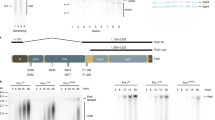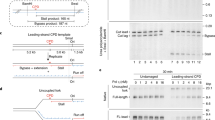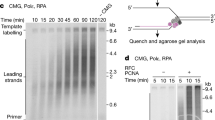Abstract
Here we show that exposure of aphidicolin-arrested Chinese hamster ovary (CHO) cells to the protein-kinase inhibitors 2-aminopurine or caffeine results in initiation of replication at successively later-replicating chromosomal domains, loss of the capacity to synthesize DNA at earlier-replicating sites, release of Mcm2 proteins from chromatin, and redistribution of PCNA and RPA from early- to late-replicating domains in the absence of detectable elongation of replication forks. These results provide evidence that, under conditions of replicational stress, checkpoint controls not only prevent further initiation but may also be required to actively maintain the integrity of stalled replication complexes.
This is a preview of subscription content, access via your institution
Access options
Subscribe to this journal
Receive 12 print issues and online access
$209.00 per year
only $17.42 per issue
Buy this article
- Purchase on Springer Link
- Instant access to full article PDF
Prices may be subject to local taxes which are calculated during checkout







Similar content being viewed by others
References
Gilbert, D. M. Temporal order of replication of Xenopus laevis 5S ribosomal RNA genes in somatic cells. Proc. Natl Acad. Sci. USA 83, 2924–2928 (1986).
Hatton, K. S. et al. Replication program of active and inactive multigene families in mammalian cells. Mol. Cell Biol. 8, 2149–2158 (1988).
Ma, H. et al. Spatial and temporal dynamics of DNA replication sites in mammalian cells. J. Cell Biol. 143, 1415–1425 (1998).
Dimitrova, D. S. & Gilbert, D. M. The spatial position and replication timing of chromosomal domains are both established in early G1-phase. Mol. Cell 4, 983–993 (1999).
Diffley, J. F. Replication control: choreographing replication origins. Curr. Biol. 8, R771–R773 (1998).
Hamlin, J. L. Effect of damage to early, middle, and late-replicating DNA on progress through the S period in Chinese hamster ovary cells. Exp. Cell Res. 112, 225–232 (1978).
Larner, J. M., Lee, H. & Hamlin, J. L. Radiation effects on DNA synthesis in a defined chromosomal replicon. Mol. Cell Biol. 14, 1901–1908 (1994).
Santocanale, C., Sharma, K. & Diffley, J. F. Activation of dormant origins of DNA replication in budding yeast. Genes Dev. 13, 2360–2364 (1999).
Santocanale, C. & Diffley, J. F. A Mec1- and Rad53- dependent checkpoint controls late-firing origins of DNA replication. Nature 395, 615–618 (1998).
Shirahige, K. et al. Regulation of DNA-replication origins during cell-cycle progression. Nature 395, 618–621 (1998).
Desany, B. A., Alcasabas, A. A., Bachant, J. B. & Elledge, S. J. Recovery from DNA replicational stress is the essential function of the S-phase checkpoint pathway. Genes Dev. 12, 2956–2970 (1998).
Zhao, X., Muller, E. G. D. & Rothstein, R. A suppressor of two essential checkpoint genes identified a novel protein that negatively affects dNTP pools. Mol. Cell 2, 329–340 (1998).
Weinberger, M. et al. Induction by adozelesin and hydroxyurea of origin recognition complex- dependent DNA damage and DNA replication checkpoints in Saccharomyces cerevisiae. J. Biol. Chem. 274, 35975–35984 (1999).
Raghuraman, M., Brewer, B. & Fangman, W. Cell cycle-dependent establishment of a late replication program. Science 276, 806–809 (1997).
Andreassen, P. & Margolis, R. 2-aminopurine overrides multiple cell cycle checkpoints in BHK cells. Proc. Natl Acad. Sci. USA 89, 2272–2276 (1992).
Schlegel, R., Belinsky, G. S. & Harris, M. O. Premature mitosis induced in mammalian cells by the protein kinase inhibitors 2-aminopurine and 6-dimethylaminopurine. Cell Growth Differ. 1, 171–178 (1990).
Schlegel, R. & Pardee, A. B. Caffeine-induced uncoupling of mitosis from the completion of DNA replication in mammalian cells. Science 232, 1264–1266 (1986).
Hall-Jackson, C. A., Cross, D. A., Morrice, N. & Smythe, C. ATR is a caffeine-sensitive, DNA-activated protein kinase with a substrate specificity distinct from DNA-PK. Oncogene 18, 6707–6713 (1999).
Blasina, A., Price, B. D., Turenne, G. A. & McGowan, C. H. Caffeine inhibits the checkpoint kinase ATM. Curr. Biol. 9, 1135–1138 (1999).
Sarkaria, J. N. et al. Inhibition of ATM and ATR kinase activities by the radiosensitizing agent, caffeine. Cancer Res. 59, 4375–4382 (1999).
Dimitrova, D. S., Todorov, I. T., Melendy, T. & Gilbert, D. M. Mcm2, but not RPA, is a component of the mammalian early G1-phase pre-replication complex. J. Cell Biol. 146, 709–722 (1999).
Nakamura, H., Morita, T. & Sato, C. Structural organization of replicon domains during DNA synthetic phase in the mammalian nucleus. Exp. Cell Res. 165, 291–297 (1986).
Nethanel, T. & Kaufmann, G. Two DNA polymerases may be required for synthesis of the lagging DNA strand of simian virus 40. J. Virol. 64, 5912–5918 (1990).
Aten, J. A., Bakker, P. J. M., Stap, J., Boschman, G. A. & Veenhof, C. H. N. DNA double labelling with IdUrd and CldUrd for spatial and temporal analysis of cell proliferation and DNA replication. Histochem. J. 24, 251–259 (1992).
Meijer, L. et al. Biochemical and cellular effects of roscovitine, a potent and selective inhibitor of the cyclin-dependent kinases cdc2, cdk2 and cdk5. Eur. J. Biochem. 243, 527–536 (1997).
Dimitrova, D. S. & Gilbert, D. M. Stability and nuclear distribution of mammalian replication protein A heterotrimeric complex. Exp. Cell Res. 254, 321–327 (2000).
Holmquist, G. P. & Caston, L. A. Replication time of interspersed repetitive DNA sequences in hamsters. Biochim. Biophys. Acta 868, 164–177 (1986).
Caddle, M. S. & Heintz, N. H. The replication timing of the amplified dihydrofolate reductase genes in the Chinese hamster ovary cell line CHOC 400. Biochem. Biophys. Res. Commun. 170, 134–139 (1990).
Dijkwel, P. A. & Hamlin, J. L. The chinese hamster dihidrofolate reductase origin consists of multiple potential nascent-strand start sites. Mol. Cell Biol. 15, 3023–3031 (1995).
Painter, R. B. & Young, B. R. Radiosensitivity in ataxia-telangiectasia: a new explanation. Proc. Natl Acad. Sci. USA 77, 7315–7317 (1980).
Zakian, V. ATM-related genes: what do they tell us about functions of the human gene? Cell 82, 685–687 (1995).
Santocanale, C. & Diffley, J.F. ORC- and Cdc6-dependent complexes at active and inactive chromosomal replication origins in Saccharomyces cerevisiae. EMBO J. 15, 6671–6679 (1996).
Tibbetts, R. S. et al. A role for ATR in the DNA damage-induced phosphorylation of p53. Genes Dev. 13, 152–157 (1999).
Xu, Y. & Baltimore, D. Dual roles of ATM in the cellular response to radiation and in cell growth control. Genes Dev. 10, 2401–2410 (1996).
Smith, G. C. et al. Purification and DNA binding properties of the ataxia-telangiectasia gene product ATM. Proc. Natl Acad. Sci. USA 96, 11134–11139 (1999).
Vassilev, L. T. & DePamphilis, M. L. Guide to identification of origins of DNA replication in eukaryotic cell chromosomes. Crit. Rev. Biochem. Mol. Biol. 27, 445–472 (1992).
Hamlin, J. L., Mosca, P. J. & Levenson, V. V. Defining origins of replication in mammalian cells. Biochim. Biophys. Acta 1198, 85–111 (1994).
Gilbert, D. M., Miyazawa, H. & DePamphilis, M. L. Site-specific initiation of DNA replication in Xenopus egg extract requires nuclear structure. Mol. Cell Biol. 15, 2942–2954 (1995).
Lawlis, S. J., Keezer, S. M., Wu, J -R. & Gilbert, D. M. Chromosome architecture can dictate site-specific initiation of DNA replication in Xenopus egg extracts. J. Cell Biol. 135, 1–12 (1996).
Visser, A. E. & Aten, J. A. Chromosomes as well as chromosomal subdomains constitute distinct units in interphase nuclei. J. Cell Sci. 112, 3353–3360 (1999).
Jackson, D. A. & Pombo, A. Replicon clusters are stable units of chromosome structure: evidence that nuclear organization contributes to the efficient activation and propagation of S phase in human cells. J. Cell Biol. 140, 1285–1295 (1998).
Acknowledgements
We thank J. Chen for technical assistance with flow cytometry, and P. Hahn, A. McNairn and B. Knox for critical reading of the manuscript. This work was supported by NIH grant GM57233-01 (to D.M.G.).
Author information
Authors and Affiliations
Corresponding author
Additional information
Correspondence and requests for materials should be addressed to D.M.G.
Rights and permissions
About this article
Cite this article
Dimitrova, D., Gilbert, D. Temporally coordinated assembly and disassembly of replication factories in the absence of DNA synthesis. Nat Cell Biol 2, 686–694 (2000). https://doi.org/10.1038/35036309
Received:
Revised:
Accepted:
Published:
Issue Date:
DOI: https://doi.org/10.1038/35036309
This article is cited by
-
Single-molecule analysis reveals that DNA replication dynamics vary across the course of schizogony in the malaria parasite Plasmodium falciparum
Scientific Reports (2017)
-
The impact of replication stress on replication dynamics and DNA damage in vertebrate cells
Nature Reviews Genetics (2017)
-
Transfection with thymidine kinase permits bromodeoxyuridine labelling of DNA replication in the human malaria parasite Plasmodium falciparum
Malaria Journal (2015)
-
CDK targeting of NBS1 promotes DNA‐end resection, replication restart and homologous recombination
EMBO reports (2012)
-
Premature chromosome condensation induced by caffeine, 2-aminopurine, staurosporine and sodium metavanadate in S-phase arrested HeLa cells is associated with a decrease in Chk1 phosphorylation, formation of phospho-H2AX and minor cytoskeletal rearrangements
Histochemistry and Cell Biology (2011)



